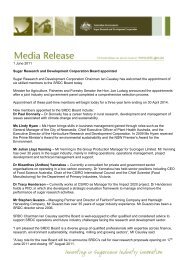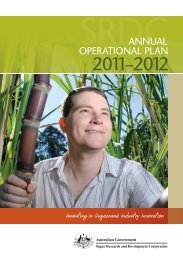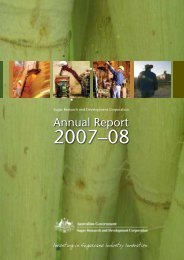Section 2 - Sugar Research and Development Corporation
Section 2 - Sugar Research and Development Corporation
Section 2 - Sugar Research and Development Corporation
You also want an ePaper? Increase the reach of your titles
YUMPU automatically turns print PDFs into web optimized ePapers that Google loves.
Better frost tolerant varieties for NSW –<br />
NSW Farming Systems Group<br />
Frost damage to sugarcane crops affects about<br />
one third of the NSW cane growing l<strong>and</strong>s reducing<br />
production by 10 – 30% <strong>and</strong> costing the industry<br />
up to $2.5 million in about one in three years.<br />
This project tested whether artifi cial freeze testing<br />
of cane seedlings could be used to identify cane<br />
varieties that would perform well under fi eld<br />
frosting conditions.<br />
Trials ascertained whether subjecting seedlings<br />
to cold room freezing would produce a similar<br />
level of damage to that in the fi eld <strong>and</strong> determine<br />
an appropriate testing regime of temperature<br />
<strong>and</strong> duration.<br />
There was some differentiation between varieties,<br />
however the degree of differentiation between<br />
the good, average <strong>and</strong> poor categories was very<br />
small <strong>and</strong> the majority of individual trials failed<br />
to show any statistical signifi cance. The trials have<br />
shown that it is diffi cult to clearly correlate ratings<br />
derived by artifi cial freeze testing of seedlings with<br />
known fi eld reaction of more mature cane plants.<br />
Further work may be able to refi ne the techniques<br />
but at this stage it’s not reliable enough to use in<br />
recommendations to farmers on frost tolerance<br />
(GGP041).<br />
The next step for Precision Agriculture –<br />
Homebush Innovative Grower Group<br />
The Homebush Innovative Farmers group, working<br />
with Queensl<strong>and</strong> Government farming systems<br />
agronomist, John Hughes, conducted a longterm<br />
replicated trial to identify agronomic issues<br />
infl uencing yield variability <strong>and</strong> the subsequent<br />
development of zonal management techniques<br />
for spatially defi ned soil groups.<br />
The aim was to determine the yield potential of<br />
cane on paddock geo-referenced soil groups with<br />
known characteristics <strong>and</strong> to identify ways to<br />
maximise productivity from those soils with the<br />
best mix of water <strong>and</strong> nutrient management <strong>and</strong><br />
Precision Agriculture (PA).<br />
The trial compared soil bulk density values,<br />
soil penetration resistance, water infi ltration<br />
<strong>and</strong> yield across defi ned soil groups in a<br />
conventionally grown, traffi c-free crop, <strong>and</strong><br />
bare soil environment.<br />
Particle size <strong>and</strong> chemical analysis results<br />
confi rmed the ability of electrical conductivity<br />
(EC) soil mapping to spatially differentiate<br />
zones of contrasting soil properties <strong>and</strong> groundtruthing<br />
validated the ability of EC soil mapping<br />
to accurately defi ne variability within-paddocks<br />
<strong>and</strong> across the farming enterprise. The study<br />
revealed the inadequacy of 1:100,000 coarse<br />
scale soil surveys to support PA where the farm<br />
is mapped as one soil unit.<br />
There was no signifi cant difference in yield <strong>and</strong><br />
stalk counts across the soil groups in the plant<br />
cane phase. Unfortunately cyclonic conditions<br />
severely impacted on the integrity of the yield<br />
data in the ratoon phase.<br />
However, subsequent ground-truthing of yield<br />
patterns from processed satellite imagery<br />
provided invaluable information that clearly<br />
demonstrated the relationships <strong>and</strong> interaction<br />
between soil properties, elevation/ topography<br />
<strong>and</strong> within-paddock yield variability. A number<br />
of possible PA management practices emerged<br />
from this component of the project that will<br />
provide a potential pathway to manage withinpaddock<br />
yield variability <strong>and</strong> the geographic<br />
information system layers that will underpin<br />
PA in the future (GGP052).<br />
SRDC Annual Report 2010–2011 61






